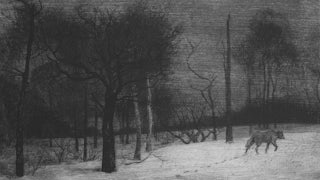In the early 1970s, ranchers in the Southwest began to share strange reports of cattle mutilations—carcasses discovered with organs missing, and with no obvious physical explanation for the deaths. A variety of culprits were suggested—secret government programs, satanists, cults, or extraterrestrials—despite multiple forensic investigations that turned up nothing suspicious about the deaths.
Then this spring, a minor police report about the mutilations of six cattle in Texas went from a Facebook post to multiple national articles in a matter of days. Why did such a seemingly small incident strike such a chord, and what does the American fascination with this particular conspiracy theory say about us? On episode 68 of The Politics of Everything, hosts Laura Marsh and Alex Pareene chat with Michael J. Goleman, a historian who researched the first great wave of cattle mutilations in the 1970s, and with cultural historian Colin Dickey, who has written extensively about American conspiracy theories, about their historical cycles and why, in the twenty-first century, they seem to have taken a very dark turn.
[Audio clip]: “A bizarre mystery now gaining attention on a national level, cows found mutilated, some of them cut with precision, their bodies seemingly untouched with no bloodshed.”
Laura Marsh: In April, the Madison County Sheriff’s Office in Texas announced its investigation into a strange phenomenon, the death and mutilation of six cattle.
Alex Pareene: The story quickly became national news, and attention turned to possible culprits.
Laura: This was big in tabloids, like the New York Post, and on cable. Fox News has been on the cattle mutilation beat for a while. Tucker Carlson made a whole documentary about it last year. He claims that over 10,000 cows have been mutilated in the past 40 years, and interviews locals who wonder if it’s the product of biological weapons testing or UFOs.
Alex: But this mystery has spilled out of the right-wing conspiracy sphere. The New York Times reported on mutilations and even leaned into the alien angle, likening it to something out of The X-Files.
Laura: Everyone finds this story irresistible, it seems, and we’ve been telling the same story for a long time.
Alex: The first burst of reports of mysterious cattle mutilations goes back to the 1970s.
Laura: Today on the show, we’re talking about why this particular conspiracy theory persists and what our explanations say about us. I’m Laura Marsh.
Alex: And I’m Alex Pareene.
Laura: This is The Politics of Everything.
Alex: A report about cattle mutilations in Texas sounds essentially like a local story. Dead livestock is not something we would normally hear about across the country, but the mystery has gone national. The first question is why. We’re talking to cultural historian Colin Dickey, who has written extensively about myths and conspiracy theories in American life. Colin, thanks for talking to us today.
Colin Dickey: Hey, thanks for having me on.
Alex: So, this report is pretty grisly. At the same time, it’s the story of a dead cow, essentially. Why would this get picked up nationwide? Why is this news?
Colin: I mean, it’s a really fascinating history into why in certain moments in time people tend to freak out about animal mutilations, specifically cattle mutilations. There’s a whole backstory of the cattle mutilations or, as they’re informally known amongst the UFO and fringe community, “the mutes.” The mutes flourished in the 1970s as a going concern, and then they got relegated into just a pop-culture, almost pre-internet meme, an X-Files/South Park thing, but I think we are at a moment now when we’re cycling back to some of the paranoia anxiety that typified the ’70s and the early ’80s. Suddenly these cattle mutilations are going to be taken seriously in a way they might not have otherwise been 20 years ago or 30 years ago.
Laura: Something that’s funny about it is you mentioned there’s this long history and there’s even a genre name for this kind of story, but it’s reported as if this is just some brand new happening that came out of nowhere and is just an unsolved mystery, completely inexplicable.
Colin: The New Yorker had a longer piece on this recent spate of mutes which does the work of connecting it to this earlier history. But one of the great problems with conspiracy theories is that they tend to be treated as sui generis and ex nihilo—however we’re saying it these days. But all these things tend to be connected. The current obsession with the Democrats as sexual predators and pedophiles is basically a recast of the satanic panic of the 1980s, which is also in turn a recast of the anti-Catholic panic of the 1830s. So these things happen over and over again. And then we developed this kind of cultural amnesia.
Laura: One of the other things that is left out of news reports is other plausible explanations for the mutilations. What is the likeliest cause of cows being found without tongues?
Colin: The likeliest cause is the work of scavengers: foxes, coyotes, vultures. If you think about a cow, if you picture a dead cow in your mind, recently deceased in some manner or another, and you are a small little scavenger like a coyote, what are you going to do? You’re going to go for the easiest bits, the easiest meat. And it turns out that the softest parts of a dead cow are things like its tongue, or its anus, and the eyes.
Alex: You’re not going to go for the good, what we would consider, the good cuts?
Colin: Exactly right. You, you don’t see a lot of like coyotes butchering a side beef for its prime cuts. No, you go for what’s easy. And so what happens with these deceased cattle is they’re set upon by scavengers and, at a certain point in the evolution of decay, what you’ll find is a mostly intact body with its softest, fleshiest bits removed. If you don’t know what’s happening, sure, that can seem weird and strange. And if we’re talking about the anus, in particular, being chewed out then, you know, that often seems like, “Oh, wow, I can’t imagine that ever happening.” But it’s very clearly scavenger behavior, and that’s been documented time and time again.
Laura: I also want to get to a big unexplained feature of these stories. Often there’s like there were no footprints or no tracks of wheels leading up to these things. And that is because like vultures … fly through the air, or other scavengers walk through a field the same way a cow would.
Colin: Right. Yeah. And it’s a reverse Occam’s razor that happens with a lot of conspiracy theories. It’s where once you have decided that the obvious answer is not plausible, everything starts to seem strange and uncanny in ways that are all based around our refusal to look at the most obvious and self-evident answer.
Laura: The other thing that strikes me as interesting is this refusal to acknowledge that scavengers could ever be the reason. You think about the Dyatlov Pass incident, where another big part of that story is that the victims were found with the tongues removed. Again, it’s the same reason: It would be scavengers, but [instead] it has to be like Soviet research or UFOs—it has to be the thing that we’re worried about at that moment in history.
Colin: Yeah, most of us don’t work with animals on a day-to-day basis. So a lot of us just don’t have any familiarity with how nature works in the absence of human intervention. And so people come across natural scavenger behavior and say, “Literally, I have never seen anything like this before.” Like, how could this possibly be?
Laura: Yeah. I also wonder if there’s an element of people being so insistent on this idea of property, like I can fence off a field and then that area is in civilization and it’s unthinkable that a vulture or a coyote could come in and do something there that I’m not in control of.
Colin: Right, how could it possibly happen that the natural world is actually not entirely controlled by us?
Laura: Colin, thank you so much.
Alex: After the break, we’ll dig into the strange decades-long history of cattle mutilation.
Laura: As we’ve heard, stories about cattle mutilations go back a long way. Their heyday was in the 1970s when, according to news from that time, ranchers reported over 10,000 mutilations. The mystery spread across 11 states, according to The New York Times. And it attracted all manner of wild explanations, from aliens to cults, but one suspect loomed particularly large: the federal government. Michael J. Goleman is a historian at Somerset Community College, and he’s examined this particular theory in detail. Michael, welcome to the show.
Michael J. Goleman: Thank you for having me.
Laura: Recently there was a report about the possible mutilation of half a dozen cattle, but the number of incidents in the 1970s seemed exceptionally high. How were people keeping track of them?
Michael: Honestly, they weren’t really, so that 10,000 number is definitely inflated. There were some independent investigators who, when they tried to verify that number, found that it was someone who came up with, “Well, we had 20 in this area and maybe only one out of every five is reported,” and then started doing some multiplying, and then news outlets just used that number and ran with it.
Laura: When you go through this list of paranormal activity, UFOs, military experiments, it’s like an elevator pitch for any X-Files episode: cows found without tongues, creepy stuff going on with aliens. How did those narratives begin to form?
Michael: So that’s what’s fascinating about it is who actually led the charge to pull that narrative toward UFOs. They were the ufologists themselves. Those that wanted or desired some type of physical evidence. They could point to this as reinforcing their belief in extraterrestrial visitation. It really was those voices that tended to be the loudest in the 1970s when it came to these cattle mutilations.
Laura: Right, so they’re presumably not coming in.… The first line of response when these incidents happen, the person who finds the cow, is the farmer and then, so what happens from there?
Michael: So typically what I found during the 1970s and really even today, is you have these classic cases of mutilations, so they’re always described in the same way. But then you also have the classic reporting of the mutilations.
Laura: So could you take us through both those elements? So first of all, the description part.
Michael: Right. So classic mutilation would include, obviously, a dead cow. Typically then it’s that there are cut marks that are around like the tongue, the eyes, the nose, the bladder, the sexual organs. Farmers would report that they didn’t see any live scavengers around the area and did not see any signs of humans being within that area. So no tire tracks, no footprints. It seemed like the cow was out there in isolation.
Laura: So then what gets added to the mix by journalists who come in?
Michael: Yeah. So typically they’ll say something like surgical precision. So that it’s clear that there’s no way it could be a scavenger unless it had a scalpel. It tries to take that completely out of the picture. Then with the reporting, that’s where you see elements of, “Well, there were strange phenomena occurring prior to, or just after this mutilation.” So someone saw a light in the sky 30, 40 miles away, it’s suggestive of something else being at play rather than just natural causes.
Laura: Great. I can hear the Twilight Zone music playing as you’re describing this stuff.
Alex: I think your paper really, to a degree I didn’t know, highlights how big and national this story was. It was a phenomenon, but oddly, and I think this is worth highlighting, it was primarily small-scale ranchers that were reporting this, right?
Michael: Correct. What I ended up discovering was most of the large-scale ranchers were very skeptical of any of this type of reporting. If you look at the major publications of the ranching industry, the beef industry during the time, none of them talk about these mutilations. The absence of their voice, to me at least, said a lot, that they’re not putting a lot of stock into some of these reports. Finding dead cattle isn’t an uncommon thing. It happens. And especially where a rancher has them out and is not going and seeking them out every day, they’re out grazing or whatever.
Alex: Among the ranchers themselves, they tended to see black helicopters, and they tended to blame someone else. Who were they typically blaming for this?
Michael: Their theory tended to lean toward federal government, that there was some type of clandestine operation among federal agents to do whatever. There were theories about them trying to test biological weapons. There were theories about them just doing military operations, and the cattle were easy targets.
Alex: Right. And you describe a lot of investigations into this. It was taken seriously by even members of Congress. People were asking law enforcement to look into this quite a bit.
Michael: Absolutely, and, and there were very real efforts to try to uncover something to see if there was a group or an organization that was playing a role in this. You did have senators, Floyd Haskell from Colorado being one, who wanted a formal FBI investigation into the matter.
Laura: Can you just try and pick apart some of the politics of it for us? Why would these farmers in rural areas, Midwest, Southwest, be likely to embrace this explanation?
Michael: So the 1970s is a time when there’s quite a few profound changes within U.S. politics. We’re talking about the rise of the new right. We start to see that in figures like Barry Goldwater and eventually Ronald Reagan, who’s elected in 1980. There’s a shift politically. Also the U.S. has been involved in Vietnam and was coming out of the war. Just a few years later, you have the complete collapse of South Vietnam. You have federal investigations, the Church committee, and then, of course, Nixon, who goes through the Watergate scandal. There’s just a lot of distrust of the federal government during this period of time.
Laura: Right. So it’s not implausible that the federal government might be doing underhand things because, as we saw with the Church committee, there were experiments into mind control that the CIA was conducting at this time, which also sounds like something from an episode of the X-Files. But why were small ranches feeling particularly beleaguered?
Michael: At the same time you have all of this distrust with the federal government, the economy’s not doing very well either. Economists often refer to the issues as the Great Stagflation. One of the things that the next administration tried to do is put on price and wage controls. One of those price freezes that they put on was on beef, and so that cap on beef hurts the ranchers obviously. There were global famines that had happened, and the U.S. had sent grain to other countries that were suffering, which is going to also cause the price of feed to go up as well. And so these ranchers, they’re feeling pinched from all directions. They’re paying a higher price for feed, they’re not getting the price that they need at market for their beef. Some of the ranchers decided that they would hold back; they wouldn’t sell. And so then it causes a ripple effect where the meat packers can’t operate, they don’t have beef to distribute. The cattle industry almost collapsed.
Alex: It was called “The Wreck.”
Michael: The Wreck. Yes, correct.
Laura: So there is a parallel here because you do actually have a very real sense in which the government is coming down from on high and from afar and interfering in your business, which is cows. Then the government-interference mutilation story is just a more visceral fictional version of that. It just happens that one of them is sensationalized in imagination, and the other one is a boring policy that’s actually affecting everyone.
Michael: Right. I think maybe for some of these ranchers it was like, well, what else can go wrong? Then they come across a mutilated cow and they’re like, “Well this is probably the government too.”
Laura: So how did you start putting together the pieces of this when you started looking into it?.
Michael: I was a grad student when I first looked into this. I just started my Ph.D. work, and I was taking an agricultural history class and I needed to write a paper that semester. And it was a class that I wasn’t too keen on taking, and it did come down to an episode of the X-Files. I was rewatching it at the time and they mentioned cattle mutilations, and so I told my professor that that’s what I was going to look into. And he just laughed, and I don’t think he knew that I was actually serious. But when I first started looking into it, what was so fascinating is that there were definitive dates. As I started digging in further, they matched up with these major forces—economic forces, political forces—that were going on at the time. And, for a historian, those are too many coincidences to just turn a blind eye to—
Alex: No, that’s really fascinating because basically, this comes out of nowhere in the early 1970s and then largely disappears as economic conditions improve.
Michael: Absolutely. So by the 1980s, you still have some of these mutilation things floating around. But by the end of that decade, that was when like the crop circle thing started—
Alex: They moved on to the crop circle thing.
Michael: Right. So it just progressed into something else.
Alex: You cover some of the people that did investigate this pretty thoroughly. And just to be clear for the record, most of what was found as mutilation was pretty consistent with basically what scavengers would do to a dead cow.
Michael: Yeah. The Colorado Bureau of Investigation had some resources that they could use behind their investigation. They sent some of these carcasses for necropsy. The veterinary pathologists, their conclusions were that the cause of death was natural. Some of the bodies, they couldn’t determine for sure. It could have been a knife mark or it could have been scavenger activity, but by that point, the body was too far decayed. There were very few instances where anyone could firmly declare that it was anything but scavenger activity.
Alex: Of course in the world of conspiracies that itself is evidence of the cover-up. The government investigators found no evidence of foul play; that itself becomes supporting evidence.
Michael: Correct. There could have potentially been copycats: teenagers going out there and just messing around and, not that they maybe killed any cattle but took a knife to one afterward finding it dead.
Alex: Especially as the story spreads, you have to imagine there probably were people just going and doing strange things, right? It was the ’70s. But like you mentioned, the government had actually poisoned a bunch of livestock in the ’60s and denied it for decades. Was it sheep or something?
Michael: It was sheep, in Utah, the Dugway Proving Grounds. They were just downwind; maybe it was an accident. It probably was, but it killed a large number of sheep. And you’re right, the government did deny any type of involvement or activity in that.
Laura: And why would they deny that? Is it because the operation they were carrying out that caused it was secret?
Michael: Right. We also have to remember that we’re still in the middle of the Cold War, and so any type of government activity that has to do with military technology, bioweapons, anything like that, is going to be highly classified.
Laura: The other thing that’s emerged more in the last few years is that the U.S. government was doing research into bioweapons in the years after the second World War. So it’s not unreasonable to imagine the government could be interested in livestock for some reason. But in this case, there’s just like a simpler explanation.
Michael Goleman: Absolutely. There are scholars that have studied conspiracy theories and conspiracy theories involved with the federal government, and the federal government seems to put on a classic case of how to create conspiracy theories because they usually are trying to hide something, but it’s not what people think they’re trying to hide. So people are put in a position of trying to fill in the gaps.
Laura: One last question I have is also whether the attraction of some of those conspiracy theories is about building a political identity, especially if you’re in a remote or rural area and you don’t feel that involved in the mainstream of politics. Having this anti-government dance and this very rich, imaginative life of conspiracy theories can also be a substitute for that.
Michael: Absolutely, and especially in the western parts of the U.S. where public land use has been such a controversial issue, where the federal government still owns quite a bit of that land and you have ranchers and farmers who are wanting to use that land. There’s already tension between their livelihood and the federal government standing in the way of them being able to do things bigger and better.
Alex: All right, well, I’m feeling even more Scully-like than usual after that conversation, but thank you so much for talking to us today, Michael.
Michael: Thank you. I appreciate you having me.
Laura: Michael J. Goleman’s paper, “Wave of Mutilation,” is available on jstor.org.
Alex: After the break we’ll be back with Colin Dickey to talk about the historical cycles of American conspiracy theories and why, in the twenty-first century, they seem to have taken a much darker turn.
Alex: We’ve learned about the first wave of cattle mutilation reports in the 1970s and the political and economic conditions that they happened within. It can seem, in some sense, like we have never escaped the ’70s.
Laura: We have a whole episode on that.
Alex: Yeah, we do have. Go ahead. Go to the archives. conditions are different now. There’s inflation just as there was then, but it’s not quite the same situation as it would’ve been for cattle ranchers in the 1970s. So I’m just wondering, Colin, to what extent do you think that material conditions influence stories like this and maybe the return of cattle mutilation as a salient myth?
Colin: Yeah, I think that the best way I’ve found to think about a conspiracy is that a conspiracy theory exists to impose a false sense of order on chaos. Karl Popper, you know, his quote is, Conspiracy theory thinking happens when you get rid of God and ask what’s in his place. This idea that the conspiracy theory posits a group of people, often racistly, the Jews or somebody like that, or more diffusely the Illuminati or something. But they are the ones pulling the strings, could be Satan, behind the seemingly disparate chaos and sense of disorder in the world. With cow mutilations, it’s really fascinating because once again you have something which seems so kind of inexplicable on its face, and so you start immediately looking for some hidden causal mechanism that can reduce the mystery into something explainable. As you guys have already talked about in the seventies, that is black helicopters and federal intervention. And then that gradually becomes satanists and then eventually becomes about UFOs.
Laura: It’s really interesting to see the progression of explanations laid out, from federal government, to Satan, to UFOs, because they each seem to capture a different type of anxiety for a different microera. Do you have any theories about how each one kind of matches up to the period that it pops up in?
Colin: With the mutes, it’s a good example where you start by positing that maybe it’s the government, but, since you have senators and various people weighing in to get to the bottom of this, you actually get the government on your side. And then that doesn’t work as a mechanism anymore. So then you get satanists. The satanists were… In a weird way, the cattle mutilations were too early for the satanists
Alex: The satanic panic.
Colin: Yeah, the satanic panic doesn’t really hit until the ’80s and it has a lot more to do with suburban parents’ anxiety and about their kids being at daycare all day long. That kind of thing.
Alex: It was interesting, because that’s what our other guest, Michael was saying, to some degree when this was happening in the ’70s, people investigated cults, people investigated satanists, but he was making it sound like the UFO ologist wanted it to be UFOs. The ranchers, because they were mad at the government, wanted it to be the government. It’s almost like your explanation for it has to fit into your existing understanding of the world to some extent.
Colin: Yeah, of course. Because like a belief in God, a conspiracy theory is totalizing and unfalsifiable. So if you believe UFOs are behind one thing, you believe UFOs are behind everything. Once somebody says it was aliens, it’s difficult to have any debate about that you know, like they just exist on this other
Alex: And they don’t operate, according to rules we understand. So you can’t be like, what would be the motivation for aliens to do this? Who knows.
Laura: To me, the question is always what would be not the motivation for the aliens to mutilate the cattle? Cause like, who knows, why they wouldn’t want to do that. Why would they return the bodies? Why would they be so careful about putting things back where they found them?
Colin: Again, the hallmark of the conspiratorial mindset is not just, are they doing all these terrible things in secret? They’re simultaneously letting us know and rubbing our noses in it. The whole thing about Freemasons, it’s, Oh, the Freemasons are the super-secret body that is doing all these terrible things behind the scenes. They don’t want anybody to know what they’re up to. And yet, everywhere you look, there are Freemason images—
Alex: It’s also really easy to Google them.
Laura: They have big Masonic lodges in highly visible places.
Colin: Yeah. So it becomes this weird process of hermeneutics where, Laura, to your question, why would they do that? That becomes the thing. What are they trying to tell us?
Laura: So there’s something about this story that I was drawn to because it’s refreshingly innocent compared to the kinds of conspiracy theories that we’ve seen in the last like five years. Like after PizzaGate, QAnon, on all of the far right conspiracy stuff, I felt like, Oh, cows with their tongues missing and aliens. Like how delightful. It felt very harmless and just—
Colin: Yeah, it’s real X-Files vibe. My last book, The Unidentified, which was about UFOs, it started with that question: When did this all stop being so much fun? As a Gen Xer, I grew up with The X-Files and Twin Peaks and I was like, “Yeah, this is great. This is just a harmless good ol’ time.” And you watch that fringe community get more and more dangerous and violent. They still talk about UFOs and Bigfoot, but now they talk an awful lot about guns. They talk a lot about, you know, the Illuminati and they’ve just veered further and further right. So yeah, it does feel nostalgic and innocent.
Alex: What do you think made this stuff feel almost apolitical and goofy in the ’90s. And then how did it come to be like this?
Colin: Pop culture and fringe conspiracy culture feed on each other and ping back and forth. So the UFO craze in the 1940s comes in part out of “The Shaver Mysteries,” which was a science fiction series of tales written by a guy who was probably schizophrenic, Richard Shaver, that was published in science fiction magazines, edited by Ray Palmer. And so things come out of the science fiction milieu, and then they get seized upon by people who are suffering from paranoia, anxiety. At some point that immediate panic passes, and it’s grist for a kind of nostalgia and pleasure. And The X-Files would just like ransack these paranoid forums looking for content, and then create these narratives, which then raised a generation of people who enjoyed it and knew it wasn’t serious. But also, I don’t really know any Gen X or who doesn’t harbor a deep fundamental distrust of the government, no matter their political affiliation. We were also raised to think that the government is hiding things from us, and so it just depends on where you are on the spectrum at the moment, whether it’s a fun, nostalgic entertainment or a deeply paranoid, terrifying moment.
Laura: What do you think was the tipping point where conspiracy culture went from more of a low-level paranoia and anxiety and a more of a diffuse sense of something being wrong to the very explicitly racist and politically motivated and engaged conspiracies in recent years?
Colin: Like a Black president probably, not to put too fine a point on it, or September 11. Basically between September 11, 2001, and Obama’s election, if you were a straight white person or straight white male, you began to have a sense that the culture wasn’t looking like you as much anymore, and maybe that meant that the culture was slipping away from you and you started to look for answers. Some people found solace in an extra natural explanation that allowed them to maintain their preexisting biases without having to adapt to a changing world.
Alex: It does strike me, as we’re looking at this time period, that was a time when on the right, hating the government was not actually in fashion because it was a time of patriotism. And it felt like, if anything, the election of Barack Obama meant not only that it was okay to hate the government again, but that there was a face you could put to it.
Colin: Yeah. That’s exactly right. The other thing that’s happened during that time is American white men were raised to think that their role as soldiers in making their identity through battle was over. There’s that line in Fight Club where it says, “Our generation has no great wars.” And then we get the Iraq War and it suddenly imbues these men with a chance for purpose and heroism and identity. But by 2006, it’s revealed to be a fiasco. The public turns against it. And so, this last chance for white male identity to find its purpose through war is revealed to be a sham. And then we got a Black president.
Alex: It strikes me as a difference now is the rights’ embrace of the conspiracy, that this is being something useful and helpful to the right openly, not just something they can capitalize on. It seems notable that Tucker Carlson is doing documentaries on cattle mutilation.
Colin: Yeah, I think another thing that’s worth pointing out though is a lot of this stuff was on TV in the ’80s, but it was on daytime talk shows. To speak very broadly, I’m going to say it was on media that was broadly targeted toward women, and thus not seen as serious or proper. What’s changed is that the demographic, if anything, is now skewing toward men.
Laura: It seems like we’ve had these few years of very Trumpy conspiracy theories, and a reason that I was surprised to see this cattle mutilation story pop up was it felt like suddenly there was an opening for a different kind of paranoia. And I wonder if you think that we’re at a crossroads now of leaving behind some of the cute stuff, but not knowing what’s coming next.
Colin: Oh, sure. The Trumpy stuff gets the most error in part because it’s the most serious and potentially the most dangerous. But what the anti-vax movement during the Covid pandemic has shown is that conspiracy theories really cross all political boundaries. UFOs are interesting because they don’t necessarily have a political affiliation right off the bat, and they’re more nebulous and they tap into a different kind of person. It remains to be seen whether or not we’re in a space now where more new age conspiracy theories, including UFOs, are going to be more ascendant, but I don’t think that right-wing stuff is going anywhere anytime soon.
Laura: Maybe the thing here to remember is that these conspiracy theories don’t always come labeled as belonging to the right, but that doesn’t mean that they’re any less paranoid or dangerous.
Colin: Right. I think that’s absolutely true.
Alex: All right, Colin, thank you so much for taking the time today. That was very enlightening.
Colin: Yeah. Thank you so much for having me on. This has been a lot of fun.
Laura: Colin Dickey is the author of The Unidentified: Mythical Monsters Alien Encounters, and Our Obsession with the Unexplained. His new book, Under The Eye of Power: How Fear of Secret Societies Shapes American Democracy is available for preorder now.
Alex: The Politics of Everything is co-produced by Talkhouse.
Laura: Emily Cooke is our executive producer.
Alex: Lorraine Cademartori produced this episode.
Laura: Myron Kaplan is our audio editor.
Alex: If you enjoyed The Politics of Everything and you want to support us, one thing you can do is rate and review the show. Every review helps.
Laura: Thanks for listening.








